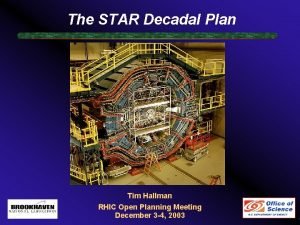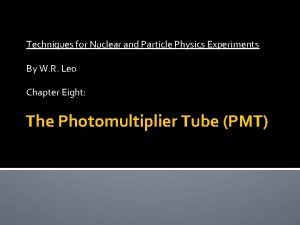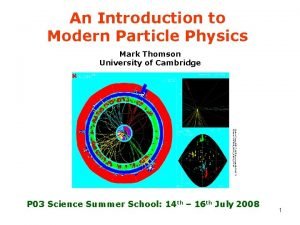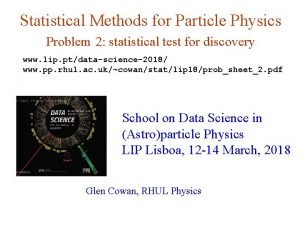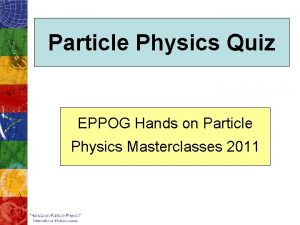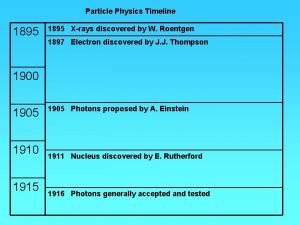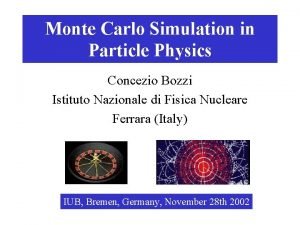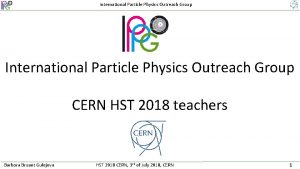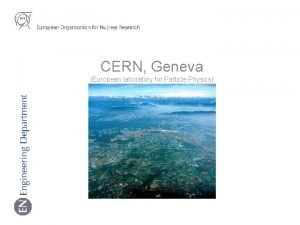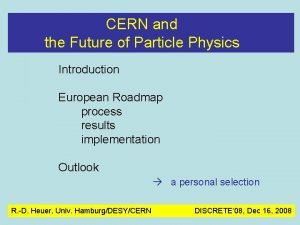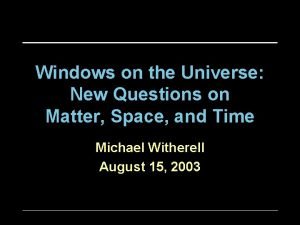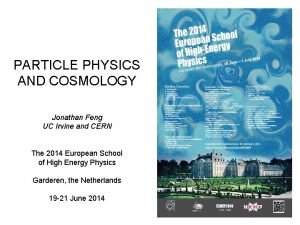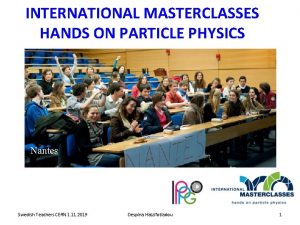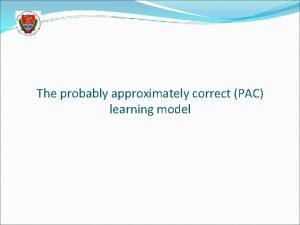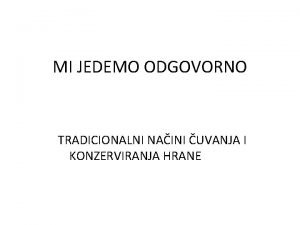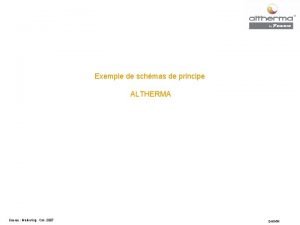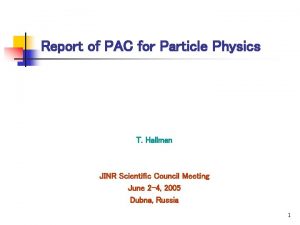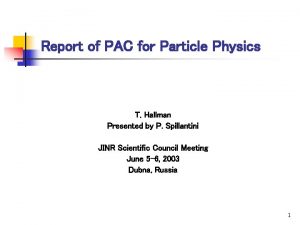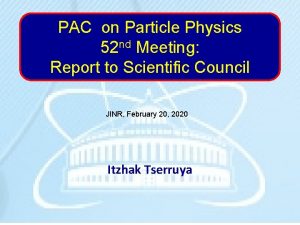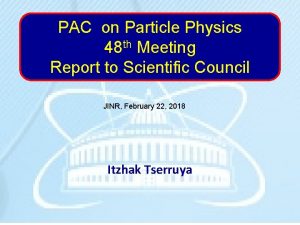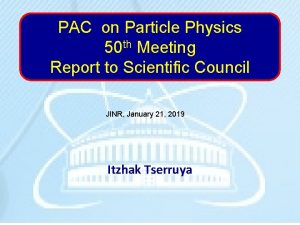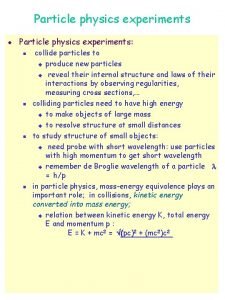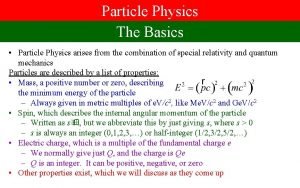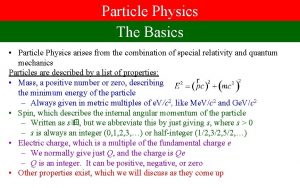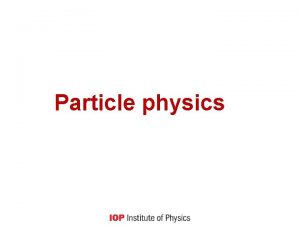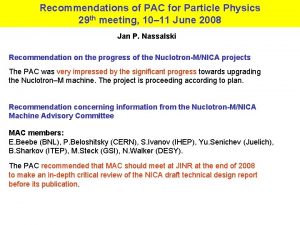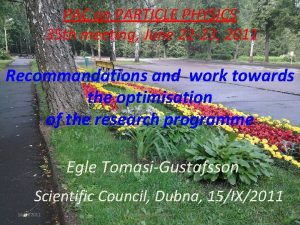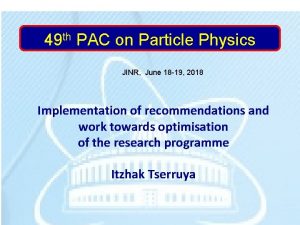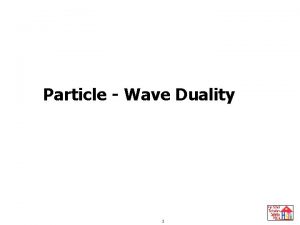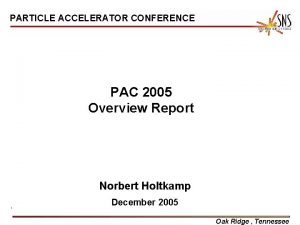Report of PAC for Particle Physics T Hallman





















- Slides: 21

Report of PAC for Particle Physics T. Hallman JINR Scientific Council Meeting January 19 -20, 2006 Dubna, Russia 1

Recommendations on New Projects n n n The PAC recommends approval of the project “Measurement of the rare decay K+ + in the experiment at the CERN SPS (project OKAPI)” with first priority until the end of 2006 (10% measurement of CKM parameter |Vtd|) The PAC recommends approval of the project “Experiments with charged kaons at the separated kaon beam of IHEP’s accelerator (project OKA) for execution with first priority until the end of 2006 (rare charged kaon decays (e. g. k+ e+ better senstivity by 2 orders of magnitude); low energy hadron interactions for tests of Ch. PT, Lattice QCD, CP violation in charge conjugate decays) The PAC recommends approval of the project “A study of asymmetries of the spin and structure-dependent interactions of nucleons with polarized targets and beams (project NN and GDH)” for execution with first priority until the end of 2006 (three 2

Recommendations on Current Experiments n Projects scheduled for review in 2005 recommended to be continued until the end of 2006: n n n n n Development of the Nuclotron Accelerator Complex (first priority) Dirac (first priority) NIS (first priority) TUS (second priority) ALPOM (first priority) p. He 3 (first priority) MARUSYA (first priority) Leading particles (second priority) Development of accelerators for radiation technologies (second priority) Analytical and methodological work to assess the prospects of 3

Recommendations on Closing Experiments n The PAC recommends closure of the following activities: n n n n DELPHI HARP/PS 214 Po. LID NN- interactions HYPERON-M HERA-B GAMMA-2 15 -20% CERES/NA 45 EXCHARM-II DISK WASA BES KAPPA SINGLET Energy Plus Transmutation reduction in No. of projects 4

JINR Particle Physics road map Draft The role of the Road Map is to: q ensure scientific excellence of JINR q maximize the scientific output within the resources q support and develop existing facilities and infrastructure 5

Worldwide Priorities in particle physics q q q the origin of mass; the properties of neutrinos; the properties of the strong interaction including properties of nuclear matter; the origin of the matter-antimatter asymmetry in the universe; the unification of particles and forces including gravity; 6

7

Search for the HIGGS; Origin of Mass; Super Symmetry JINR bears Full Responsibility JINR Participates ME 1/1 SE HE JINR in the CMS Physics Program 8

JINR in CMS Physics The field of special interest of Dubna group is study of Drell-Yan processes in the large invariant mass region The idea is to test Standard Model calculations for muon pairs production up to the highest reachable invariant masses v v Many theoretical predictions suggest possible violation of the SM Unique opportunity to test the SM up to 3 -5 Te. V mass region (Tevatron region is limited only of 0. 8 Te. V) Study facilitated by excellent performance of CMS Muon system Possibility of strong theoretical support of this research program st JINR At the stage of data taking and physics analysis JINR CMS project will be organized as a joint effort of several groups from LPP, LHE, LPP and LIT distributed following task forces: ü ü ü Data taking and technical support group (LPP and LHC) Input data control and processing (production) (P. Moissenz + 4, LPP) Data processing (V. Korenkov + 5, LIT) Physics analysis (S. Shmatov + 5, LPP) Theoretical support (O. Teryaev, D. Bardin, BLTP) 9

Search for the HIGGS; Origin of Mass; Super Symmetry The ATLAS Detector at the CERN LHC 10

Preparing to do science with ATLAS Some JINR topics are the following: Search for the SM Higgs boson with the ATLAS detector via the process H → 4μ (G. Chelkov, I. Boiko, K. Nikolaev, R. Sadikov) Other Dubna proposals are to utilize the ATLAS large-mass Higgs discovery potential by means of reactions H→ 2 W→ 2 l , or H→ 2 W→l jj (Yu. Kulchitsky) and H→ 2 Z→ 2 l , or H→ 2 Z→lljj (V. Vinogradov) on the basis of the already simulated ATLAS DC 1 and DC 2 data. The proposals rely on the Higgs boson production via the Vector Boson Fusion mechanism (the two accompanied forward jets allows very good background reduction) and on the maximal Higgs boson decay rates into WW- or ZZ-pair at MHIGGS = 400 -- 1000 Ge. V. 11

JINR preparations for physics with ATLAS : H μμμμ Study of Higgs Boson Decays H μμμμ (Boyko I. , Chelkov G. , Nikolaev K. ) n Using the full simulation of ATLAS detector n Study effects of pile-up n Background study. 12

JINR Preparations for science with ALICE TRD Electron ID MUON PHOS m+ m- pairs g, p 0 13

Planned JINR Scientific Analyses on ALICE 1. Study of hot and dense nuclear matter in nuclear – nuclear (AA) collisions in the frame of QCD predictions: n n Light resonance ( , , ) production; Chiral symmetry restoration; Particle correlations; Space-time evolution and interferometry (HBT) measurements. Heavy-quark and quarkonium ( J/ , families) production. Quarkonium suppression (Dimuons decay mode; Di-electrons decay mode). Direct photon production. ‘Prompt’ photon characteristics and two-photons correlation. 14

Physics Simulation in ALICE -- Particle Identification: n n Particle identification with Inner Tracking System and Time Projection Chamber 480 HIJING events Simulation of Φ K+K- including the tracking and detector (ITS, TPC) efficiencies n Development of New Cluster finder n Finding Algorithm n The Study of the HBT Correlations 480 HIJING events 15

Physics With ALICE Effective mass distribution of (K+K-) paires. Particle identification switched on! The resonance peak after (K+K+) background subtraction. Mass and width BW fit parameters are respectively: 1019. 60 ± 0. 04 Me. V and 4. 30 ± 0. 12 Me. V. For the BW fit the gaussian effective mass resolution (1. 23 Me. V) has been taken into account by a convolution of BW and gaussian functions. . The S/B increases from 0. 5% at the lowest p. T(K+K-) < 0. 6 Ge. V/c to 6. 2% at the highest pt > 2. 2 Ge. V/c with the significance 16

Detection of Upsilons in p-Pb and Pb-p collisions in ALICE muon spectrometer ( pt m > 3 Ge. V/c) bb BGR & Signal p-Pb 17

High-throughput Telecommunication Data Links and Local Area Network Backbone Development of external JINR computer communications: a) a highspeed 1 Gbps JINR-Moscow data link, b) JINR participation in the newgeneration research computer network with Russian and international (GLORIAD, GEANT) segments for provision of JINR’s activities, c) integration with the educational network of Dubna. 1 Gbps link to Moscow 2 November - Test run started At present the JINR LAN comprises more than 5300 computers and nodes. Main goal: carrying out organizational and technical measures to provide the 1 Gbps data transfer rate across the JINR LAN. 18

Central computer complex and Grid segment - Development of the JINR CICC as a core of the distributed infrastructure, used by 17 experiments (ATLAS, CMS, ALICE, HARP, COMPASS, DIRAC, D 0, NEMO, OPERA, HERMES, H 1, NA 48, HERA-B, STAR, KLOD, etc. ) - Development of distributed computing infrastructure according to the requirements of collaborations and users of the JINR CICC as tabulated: Year 2005 2006 2007 2010 2015 660 1000 4000 10000 Disk Space(TB) 50 200 400 800 4000 Tape(TB) 50 450 1000 6000 CPU(k. SI 2000) 100 1. 5 LHC Computing Grid Project (LCG) • LCG software testing; • evaluation of new Grid technologies (e. g. Globus toolkit 3) in a context of using in the LCG; • event generators repository, data base of physical events: support and development. 19

LIT support of LHC experiments on CCIC: Tier 1/2 Network Topology ALICE - the software developed by collaboration: Ali. En 2 - Data Challenge; own versions of ROOT; Ali. Root, Geant 3, FLUKA - analysis and processing CMS - the software at LCG-2: VO-cms-CMKIN VO-cms-OSCAR VO-cms-ORCA ATLAS - the software: ATHENA (release 9. 0. 0 and higher), ROOT 4. 04/02; TDAQ Monitoring and Control subsystems; farm management 20

Conclusions § Preparations are underway to realize the benefit of JINR’s contributions to the LHC and play a central role in the scientific programs of CMS, ALICE, and ATLAS § Activity getting underway to support a leading participation in the International Linear Collider § The exercise commissioned by the Directorate at the suggestion of the Scientific Council to streamline the particle physics program by reviewing the scientific priorities of the projects within the context of a realistic 21 budget is continuing
 Tim hallman
Tim hallman Pmt particle physics
Pmt particle physics Mark thomson particle physics
Mark thomson particle physics Particle physics
Particle physics Particle physics practice quiz
Particle physics practice quiz Particle physics timeline
Particle physics timeline Concezio bozzi
Concezio bozzi Cern particle physics
Cern particle physics European laboratory for particle physics
European laboratory for particle physics Cern particle physics
Cern particle physics Particle physics
Particle physics Form factor particle physics
Form factor particle physics International masterclasses hands on particle physics
International masterclasses hands on particle physics Stanley pac software manual
Stanley pac software manual Pac learning model
Pac learning model Stanley pac reader
Stanley pac reader Problem analysis chart examples
Problem analysis chart examples Aldrete score
Aldrete score Stanley pac reseller
Stanley pac reseller Suhi pac za špek
Suhi pac za špek Lvh criteria ecg
Lvh criteria ecg Schéma hydraulique daikin altherma
Schéma hydraulique daikin altherma
